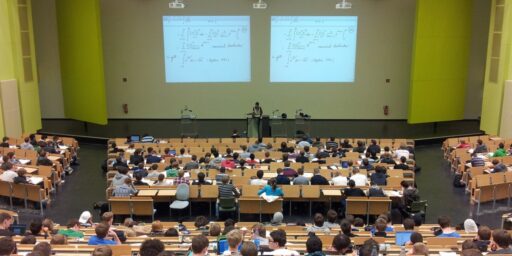Texas Limits ‘10%’ Admissions
 Texas has modified its revolutionary “10 percent” program for higher education admissions after university administrators complained that they were “going to lose control over our class.”
Texas has modified its revolutionary “10 percent” program for higher education admissions after university administrators complained that they were “going to lose control over our class.”
The “10 percent” plan in Texas has been one of the most successful experiments ever tried to get more minority students into top public universities with race-neutral criteria. It spawned similar (if less ambitious) programs in California and Florida and prompted numerous debates about equity in higher education admissions. At the behest of the University of Texas at Austin and suburban politicians, and following several years of debate, the Texas Legislature on Saturday agreed to a plan that will limit the use of the system so that Austin is required to fill only 75 percent of its freshman slots for Texans under the program.
[…]
Texas has many high schools that are overwhelmingly Latino or black — so the thinking of those who crafted the law was that 10 percent admissions would ensure that diversity would be maintained at competitive universities like UT-Austin, which would admit the top graduates of such high schools. As time has gone on, the system has worked as predicted, increasing minority enrollments at UT-Austin and also resulting in the admission of rural white students who attended high schools that previously didn’t send many students to the flagship.
While the University of Texas at Austin now has the legal right to practice affirmative action in admissions (and does so), many advocates for minority students have viewed percent plans as a key tool for promoting diversity because these plans are race neutral and because they result in admissions decisions being based on class rank, not on the SAT or ACT, standardized tests on which black and Latino students score, on average, at lower levels than do white and Asian students.
The problem with percent admissions, according UT-Austin, is that it’s too popular. “We were going to lose control over our class,” William Powers Jr., president of the university, said in an interview Sunday. He called the Legislature’s action “a very positive development.”
Many of us who oppose quota- or “numerical target-” based racial preferences were quite sympathetic to this program. It’s undeniably still affirmative action and potentially rewards mediocre students from poor communities while punishing outstanding students in hypercompetitive affluent suburbs. But it’s at least targeted to helping lift disadvantaged kids into a better life. And, by all accounts, it has been very successful in that regard.
This was, frankly, inevitable. The state’s flagship university, the University of Texas at Austin, simply can’t enroll ten percent of an enormous state’s high school students. It’s already at 50,000 students — ridiculously large — and would need to grow further. Beyond that, there are other problems:
Even though the university attracts outstanding students through 10 percent admissions, Powers said, there are gaps. There are not enough students enrolling that way who want to major in key areas such as geosciences, computer engineering and education. Earlier this year, Powers also suggested (in an argument that received plenty of attention from non-academics in Texas) that 10 percent was making it difficult to recruit athletes in key sports, since many of the best athletes are not in the top 10 percent of their high school classes.
Now, the sports recruiting argument is hard to justify, both in terms of the mission of the university and in terms of UT’s obvious success in recruiting for key sports. But the “10 percent” program is obviously making it nearly impossible to recruit international and even out-of-state students.
This modification strikes the right balance. It’s targetted only at the single campus that’s been overwhelmed by the rule and still allocates a full three quarters of the slots even there to those graduating in the top ten percent of their Texas high school class. There are enough slots for the other 12,000-odd students denied admission to the state’s flagship campus at Texas A&M, another nationally ranked school with a fine networking base.
UPDATE: I see NYT was on this story a couple days earlier and that Matt Yglesias and Kevin Drum wrote about it. Not surprisingly, they have somewhat different takes. Matt observes,
Our general understanding is that the most resources ought to flow to the “best” schools and the “best” schools ought to serve the “best” students who “deserve” to be able to go there. Under this framework, any departure from a strict scheme of “merit” looks suspicious. But another way to look at things would be to say that of course relatively able students from relatively privileged backgrounds deserve a higher education, but a larger amount of resources ought to flow to the students with more problems. After all, it’s the worse-prepared kids—typically from less privileged backgrounds—who have the most in the way of educational needs. The marginal dollar of either the taxpayer or the charitable donor will do a lot more for society when spent on people who aren’t already the best students.
That’s true up to a point. Again, while I think the justification for race-based preferences has long since ended I’m sympathetic to reaching out to people who are actually underprivileged. It does not, however, necessarily follow that ten percent of all students from the poorest Texas school districts ought attend the single best university in the state at the expense of the highest performing students. After all, as Matt repeatedly points out, simply having graduated from an elite school considered “qualification” for any job thirty years later and having been relegated to, say, Southern Methodist University permanently relegates one to ridicule as a mediocrity.
Kevin’s take is more humorous:
Never underestimate the power of suburban parents. They never give up and they never surrender.
This is not, incidentally, a bad thing. While family background, luck, and a variety of other external factors undeniably play a part in success, a goodly number of suburbanites actually worked really hard to get where they are, partly for the point of giving their children a better life than they had. While we shouldn’t punish the children of the poor for having less affluent or less involved parents, neither should we punish the children of the successful because their parents worked to put them into schools where most of the students are above average.






Excluding 25% of each class from the requirement doesn’t sound unreasonable. However, I doubt it will solve what sounds like the underlying problem. As the population of Texas grows as long as there’s a requirement to admit some proportion of its high school graduates to Texas’s public universities, the total public university capacity will need to grow. I suspect that will provide the groundwork for a showdown between the state’s anarcho-capitalists and, well, the rest of the state.
I also note that most of the reasons presented in the article were completely bogus. “Losing control over our class” is a higher priority than educating enough people? Isn’t it possible that the reason that more Texas students aren’t pursuing degrees in geoscience, computer sciences, or education are economic ones? They don’t see the prospects in those fields as good enough?
And not being able to recruit athletes? Forsooth! For the last sixty years the University of Chicago has demonstrated nicely that the elimination of varsity sports is not incompatible with a quality education. Maybe Texas will need to settle for weaker teams. Or none at all.
We’re only talking about one university here. The “top ten percenters” not admitted to UT Austin would be able to gain admittance to every single other public university — including branch campuses of UT — in the state.
Quite possibly. Presumably, though, the fact that almost all of the admittees are coming from this “top ten percent” pool complicates matters.
Further, UT-Austin is one of the top public universities in the country. In order to maintain that standing — and thus provide the value that all these people clamoring to get in are hoping to gain — is to maintain top programs in a variety of fields.
Personally, I’m not a big fan of colleges of Education, thinking teachers in fields other than perhaps special education and early childhood education would be better off majoring in their subject fields. Still, credentialing is what it is and UT has an interest in producing top graduates that will go on to teach in the state’s public schools.
Speaking from broke-California, it seems to me that state schools should return maximum economic benefit to the state. It’s not clear to me how that happens, because getting the best and the brightest educated is part of it, but they presumably have other options. On the other hand, preventing a permanent underclass also has economic benefit to the state as well.
You could call the system non-racial and still face the same quota-like questions.
Unless, of course, that you can show that subsidized education for the brightest is of maximum benefit to the state (I suspect that we’d have to restrict registration in art and music to make that work). I might be good with that …
(In my thinking you’d decide what to do based on data mining the tax receipts of past graduates.)
BTW, I suspect that UT’s football program does provide those positive economic benefits to the state.
I have, for a long time, advocated the idea of class rank in place of explicit race-based affirmative action. To a large extent you are influenced by those around you (i.e. you will probably score higher on standardized tests if you are surrounded by others who score high on standardized tests, because you study with those people and learn from their answers in class, etc.).
I didn’t realize this was being done on a wide scale in Texas. That said, the adjustment for the given reasons sounds reasonable.
Regarding the distribution of resources, I think the general goal should be to try to get the best out of everybody, which starts with a solid K-12 education. I don’t think anybody is convinced that that is happening.
If you are applying for a job at Google, or one of the companies emulating them, not going to the premier school automatically eliminates you. True, it’s an edge case, but it’s a telling one.
John writes: “If you are applying for a job at Google, or one of the companies emulating them, not going to the premier school automatically eliminates you. True, it’s an edge case, but it’s a telling one.”
That’s not true at all. School is one factor, but definitely not a necessary one. Work experience trumps schooling, and is a much better predictor of performance.
But, yes, somewhere along the line, you must show that you can stand out from the crowd through hard work and your own accomplishments.
If Texas gives slots to 10%-ers who have low probabilities of making it to graduation, what’s the utility in that? The trouble with many social “feel good” programs is that they waste valuable resources with little real hope of accomplishing anything. With all the universities in the state, you would think Texans would have enough sense to have one based on merit rather than political correctness.
So being better than everyone around you is not meritorious? Oh, wise one, what is the perfect measurement of merit? Standardized tests, I assume?
Not sure who this is directed at. Presumably, they’d do what other competitive schools do: Use a complicated calculation that includes class rank, standardized test scores, extracurriculars, essays, and various other factors rather than a single data point.
Class rank is very useful but not as a standalone. Being ranked in the second decile at an elite school doesn’t necessarily make you less meritorious than someone ranked in the first decile of a poor one. Standardized tests help provide an, um, standardized metric but they’re obviously highly flawed as well. But given how high the stakes are, more than one data point is needed.
JJ-
It was based on the comment prior to mine, which indicated that some of those in the top 10% of their class would for some reason have a low probability of being able to graduate college. I’m still wondering why. Because the school they attended didn’t have enough money for a debate team?
Gotcha. While it’s quite possible that there are people who graduate the top 10% of a weak class are unready for an elite university, I tend to think that argument is overblown. A relative merit argument is more interesting, though.
If you’re really worried about mediocrities defaulting in to the public college system, you could raise the criteria to the top 5% automatically having admission into college, and then do a combination of a high admission standard plus “exemptions” for students going into a particular area (computer science, medical, sports, whatever) to make up the rest of a student body.
I like the 10 Percent idea, to be honest. At the very least, even if it is a mediocre school, you’re still getting the students who were willing to put the most effort into their education. That’s something, particularly in areas where there are high drop-out rates.
You could always open up more university branches if the student population is getting too big. After all, it’s guaranteed entrance, not guaranteed tuition, so all those kids will be paying their tuition one way or another.
I’d be interested to know what the graduation rates are among the 10% and the other student body. If the 10%ers have lower graduation rates, that would be pretty damning. If they don’t, it’s less conclusive but harder to argue that the university is suffering a great deal when their non-10% admits aren’t doing as well.
While it’s true that those kicked off by Texas can go to A&M, it may not be long before you have a waterfall effect where A&M becomes too crowded and they have to kick down to Texas Tech or the University of Houston or an alternate UT/A&M campus.
Since the introduction of Top Ten percent, the 4-year graduation rate increased at UT from 35 percent to 55 percent or so. If anything, the program improved the academic quality of the institution.
Unfortunately, it also kept kids in rich suburban districts in the top third of their class from attending their birthright institution.
My guess — and it’s only that — is that they’ve thereby increased the percentage of students at UT for whom UT was their first choice.
I don’t know why everyone assumes kids in affluent schools are legacies. People can make the leap — as both my wife and I have — in a single generation into the upper middle class through hard work, good choices, and a little luck. We were both first generation college. We’re not at all unusual.
Odds are, our daughter will go to “better” schools than we did, since cost won’t be a top consideration. But there’s essentially a regional quota system that makes it harder for bright kids in the DC suburbs of Northern Virginia to get into the University of Virginia than it is for students in the rest of the state. Test scores and whatnot are just disproportionately better here.